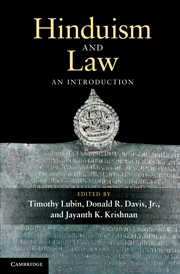Book contents
- Frontmatter
- Contents
- List of contributors
- Acknowledgements
- Chronology
- Abbreviations
- Map South Asia: political divisions c. 1860 and today
- Introduction
- Part I Hindu law
- Chapter 1 A historical overview of Hindu law
- Chapter 2 Dharmaśāstra
- Chapter 3 The practice of classical Hindu law
- Chapter 4 The creation of Anglo-Hindu law
- Chapter 5 Marriage and family in colonial Hindu law
- Chapter 6 Hindu law as personal law
- Part II Law in ancient and medieval Hindu traditions
- Part III Law and modern Hinduism
- Glossary
- Bibliography
- Index
Chapter 2 - Dharmaśāstra
a textual history
Published online by Cambridge University Press: 05 June 2012
- Frontmatter
- Contents
- List of contributors
- Acknowledgements
- Chronology
- Abbreviations
- Map South Asia: political divisions c. 1860 and today
- Introduction
- Part I Hindu law
- Chapter 1 A historical overview of Hindu law
- Chapter 2 Dharmaśāstra
- Chapter 3 The practice of classical Hindu law
- Chapter 4 The creation of Anglo-Hindu law
- Chapter 5 Marriage and family in colonial Hindu law
- Chapter 6 Hindu law as personal law
- Part II Law in ancient and medieval Hindu traditions
- Part III Law and modern Hinduism
- Glossary
- Bibliography
- Index
Summary
With an unbroken history of over two millennia, the literary production in the field of Dharmaśāstra is undoubtedly the longest in Indian history. When, at the invitation of their colonial rulers, Brahmin pandits produced a śāstra, a treatise aimed at codifying the scattered rules of Dharmaśāstra, they were following in the footsteps of their ancestors who, either at the behest of rulers or in the pursuit of scholarship, produced śāstras that presented anew and with hermeneutical acumen the inherited norms of conduct.
The beginnings of this literary tradition are lost in the fog of early Indian history, but by at least the third century bce a genre of literature focusing on the central notion of dharma came into existence. Composed first in an aphoristic style (sūtra) and then, beginning around the turn of the millennium, in simple verse (śloka), this vibrant textual production continued probably until about the ninth century ce. It was around this time that another textual form took over. In place of independent compositions, experts in dharma began writing commentaries (bhāṣya) on the ancient dharmaśāstras, as well as thematically arranged digests (nibandha) with copious citations from the dharmaśāstras. Although these three stages of textual production broadly follow a chronological sequence, there is much overlap, with sūtra texts being produced as late as the seventh century ce and original dharmaśāstras being produced well into the Middle Ages.
- Type
- Chapter
- Information
- Hinduism and LawAn Introduction, pp. 28 - 57Publisher: Cambridge University PressPrint publication year: 2010
- 10
- Cited by

